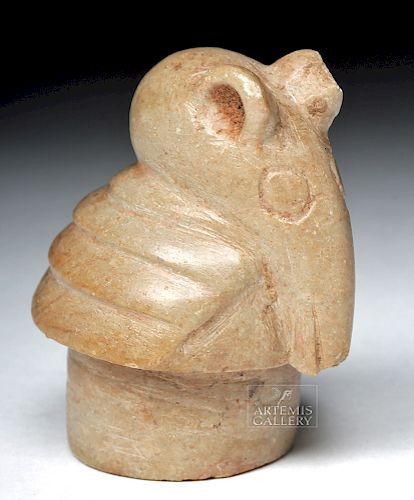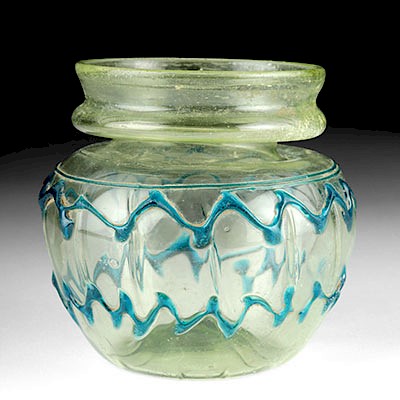Chavin Lemon-Carro Stone Drug Mortar - Armadillo
Lot 110
About Seller
Artemis Gallery
686 S Taylor Ave, Ste 106
Louisville, CO 80027
United States
Selling antiquities, ancient and ethnographic art online since 1993, Artemis Gallery specializes in Classical Antiquities (Egyptian, Greek, Roman, Near Eastern), Asian, Pre-Columbian, African / Tribal / Oceanographic art. Our extensive inventory includes pottery, stone, metal, wood, glass and textil...Read more
Estimate:
$1,900 - $2,850
Absentee vs Live bid
Two ways to bid:
- Leave a max absentee bid and the platform will bid on your behalf up to your maximum bid during the live auction.
- Bid live during the auction and your bids will be submitted real-time to the auctioneer.
Bid Increments
| Price | Bid Increment |
|---|---|
| $0 | $25 |
| $300 | $50 |
| $1,000 | $100 |
| $2,000 | $250 |
| $5,000 | $500 |
| $10,000 | $1,000 |
| $20,000 | $2,500 |
| $50,000 | $5,000 |
| $100,000 | $10,000 |
| $200,000 | $20,000 |
About Auction
By Artemis Gallery
Aug 16, 2018
Set Reminder
2018-08-16 10:00:00
2018-08-16 10:00:00
America/New_York
Bidsquare
Bidsquare : Clearance Sale - Ancient / Ethnographic Art
https://www.bidsquare.com/auctions/artemis-gallery/clearance-sale---ancient-ethnographic-art-3368
These lots are going, going, gone... plus a nice selection of lots brand-new to auction! Artemis Gallery info@artemisgallery.com
These lots are going, going, gone... plus a nice selection of lots brand-new to auction! Artemis Gallery info@artemisgallery.com
- Lot Description
**Originally Listed At $1200**
Pre-Columbian, North Coast Peru, Chavin, ca. 1200 to 500 BCE. A charming and rare example of a lemon-carro stone mortar in the form of an armadillo, one half of a mortar and pestle used for grinding materials needed to ingest hallucinogenic substances. The interior is hollowed-out for storage. The overall form of the item is that of an armadillo which exhibits a long nose, rounded ears that project forward, and incised round eyes. The shoulders of the animal are carved to resemble its armor-like shell. The armadillo's bust sits atop a rounded projection that conceals a storage area. Size: 1.5" W x 2" H (3.8 cm x 5.1 cm).
Armadillos are fascinating animals, often thought of in New World mythology as an "anomalous animal", because it presents a shell over a mammalian body. Its prodigious digging abilities led to an association with agriculture and the subterranean world, linked with the dead. South American myths describe armadillos being asked to help dig graves. This example of drug paraphernalia depicted as an armadillo probably relates to the symbolic links between shamanism and death.
Lemon Carro is a famous site on the Jequetepeque river in northern Peru where hallucinogenic miniature drug poporos in stone of very high quality were discovered. It is near Tembladera, a site for first class Chavin ceramic vessels.
Provenance: private Hawaii, USA collection; ex-Ferdinand Anton collection, a famous Pre-Columbian art expert and author of Germany
All items legal to buy/sell under U.S. Statute covering cultural patrimony Code 2600, CHAPTER 14, and are guaranteed to be as described or your money back.
A Certificate of Authenticity will accompany all winning bids.
We ship worldwide and handle all shipping in-house for your convenience.
#131965Age-commensurate surface wear, small chips to one ear, nose, and rim base, with some discoloration, otherwise excellent. Light earthen and mineral deposits throughout. An old adhesive mark on verso of head.Condition
- Shipping Info
-
All shipping is handled in-house for your convenience. Your invoice from Artemis Gallery will include shipping calculation instructions. If in doubt, please inquire BEFORE bidding for estimated shipping costs for individual items.
-
- Buyer's Premium



 EUR
EUR CAD
CAD AUD
AUD GBP
GBP MXN
MXN HKD
HKD CNY
CNY MYR
MYR SEK
SEK SGD
SGD CHF
CHF THB
THB


















